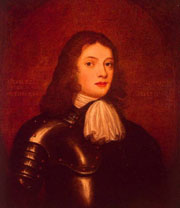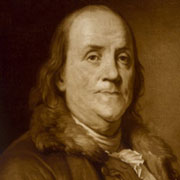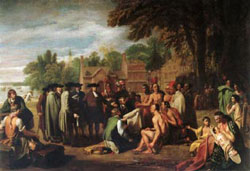Small Planet Communications, Inc. + 15 Union Street, Lawrence, MA 01840 + (978) 794-2201 + Contact







William Penn, a Quaker, established the Province of Pennsylvania as a haven for persecuted members of the Society of Friends. He called the colony the "Holy Experiment." Many English and Welsh Quakers responded to Penn's offers of sanctuary and land in the New World. They sailed to join the British, Dutch, Swedes, and Finns who had already settled there.
Peaceful relations with neighboring American Indian groups and fertile farmland helped Penn's experiment become a success. Philadelphia grew into one of the most important cities in colonial America, becoming the birthplace of the U.S. Constitution.
Click to view a historic map
of Pennsylvania and New
Jersey, circa 1698.
DID YOU KNOW?
Pennsylvania is the only one
of the 13 original colonies that
does not border the Atlantic
Ocean. Click to read more
Pennsylvania fun facts.
Before European settlement, Pennsylvania was the home of about 15,000 American Indians. Algonquian-speaking Delaware groups lived in the eastern river valleys. The Susquehannock, an Iroquoian tribe, lived along the Susquehanna River. The Shawnee lived in the interior regions of present-day Pennsylvania.
Much of what is now Pennsylvania was part of the original land grant for the Virginia colony given to the London Company in 1606. As early as 1615, the French and Dutch explored some of this land. French explorer Étienne Brûlé is believed to have explored the Susquehanna River from the north. Cornelius Hendricksen, a Dutch captain, sailed up the Delaware River to where it met the Schuylkill River.

Read about Pennsylvania's
founder, William Penn.
The founder of Pennsylvania was William Penn, a prominent British Quaker. His father, Sir William Penn, a senior naval commander during the first and second Dutch wars, introduced his son to King Charles II. The younger Penn went on to become a trusted friend of James, the Duke of York. When the elder Penn died in 1670, his son inherited a large fortune, which he used to help other Quakers escape religious persecution in England. In return for a debt King Charles II owed to his father, Penn asked the king for a portion of the New York colony. Charles II agreed, and Penn obtained a grant of territory known as the province of Pennsylvania, a name chosen to honor his father.
Penn's first step in obtaining his charter was to dispatch his cousin, William Markham, to America in April of 1681. Markham was to appoint a council and ensure that the Welsh, Swedish, Dutch, and Irish settlers already there, as well as the American Indians, recognized his proprietary authority. At this point in time, Penn referred to himself as governor of the new colony, which he called the "Holy Experiment," and soon hoped to take up his duties in person.
Penn circulated a pamphlet in England, Wales, Holland, and Germany—countries where the Society of Friends was well established. The pamphlet described the proposed settlement in the New World. Settlers soon poured into the region from Europe, drawn to it by Penn's attractive terms for land purchases and rentals, as well as the promise of religious toleration and participation in lawmaking.
An initial detachment of settlers departed for America in October 1681 with four commissioners on board. Among them was Thomas Holme, who was to survey the site for Penn's new town, Philadelphia, on the banks of the Delaware and Schuylkill rivers. On April 25, 1682, Penn issued a more complete frame of government and charter of liberties.
Read more about
Philadelphia's history.
DID YOU KNOW?
Pennsylvania Dutch Country
was not named for its settlers
of Dutch descent. Due to the
large number of German
emigrants who settled there
in the 18th century, Dutch
became a variation of the
word "Deutsch," which means
German.
The first settlers soon discovered that the land along the river was particularly fertile, and a favorable site was found for the principal town and port of Philadelphia, which means "brotherly love" in Greek.
The settlement around Philadelphia experienced rapid growth. Within a year, crops were being harvested, and the surplus was shipped for export. When Penn arrived in late 1682 to take up the governorship, he was pleased to see that the settlement had already prospered. By 1685, the population of Pennsylvania had reached 9,000.
In the early 1700s, thousands of Germans settled in Pennsylvania. Many of them were members of persecuted religious groups such as the Mennonites and the Amish. They settled the fertile farmland between Philadelphia and the Blue Mountains, an area that is now known as Pennsylvania Dutch country.
A large number of Scots-Irish arrived, beginning around 1717. Within 30 years, they had settled the valleys in the western part of the region. People from other colonies also settled land that would soon become part of Pennsylvania.
Penn treated the American Indians as equals and scrupulously paid for land received from the local chiefs. Penn signed a treaty of friendship in 1682 with the Delaware Indians of Pennsylvania, setting a high standard in relations. Because the American Indians generally aided the early settlers, Penn's colony suffered fewer periods of hardship that were common in other colonies.
After Penn's death in 1718, the era of friendship with the American Indians came to an end. In 1737, colonial authorities claimed to have found a lost treaty from 1686 ceding a tract of Delaware tribal land between the fork of the Delaware and Lehigh rivers that extended as far as a man could walk in one and a half days. Three of the fastest walkers in the colony were hired. The Englishmen crossed the land twice as fast as the Delaware had anticipated, resulting in the tribe losing about 1,200 square miles of their land. When the Delaware protested this "Walking Purchase," the Iroquois forced them to leave the region. Angry over the fraudulent land deal, many of the Shawnee and Delaware migrated to western Pennsylvania and Ohio and became allies of the French, who promised them a chance to battle the British colonists.

Read about Benjamin Franklin.
Benjamin Franklin came to Philadelphia from Boston in 1723. Among Franklin's many professions and hobbies were author, inventor, philosopher, printer, and newspaper editor. He soon became involved in the politics of the colony and is remembered as an important figure in the history of Pennsylvania and in the early development of the United States.
Discover more about
Pennsylvania state
history.
In the 1750s, British traders and settlers moved into western Pennsylvania, eager for land and furs. The French built a chain of forts from Lake Erie to the Forks of the Ohio River and pressured the American Indians to break relations with the British. The French and Indian War began in Pennsylvania in 1754. Following his victory at Fort Duquesne in 1758, British General John Forbes renamed the site Pittsburgh. After the British won the war, the French withdrew, and peace came to western Pennsylvania. In 1768, American Indians signed the Fort Stanwix Treaty, under which the native peoples sold their interest in lands south of the Ohio and Susquehanna Rivers. Most American Indians eventually migrated west, leaving only a few remaining in Pennsylvania.
Pennsylvania | Bibliography
- Encyclopædia Britannica. "Treaties of Fort Stanwix." Accessed 6/17/19. http://www.britannica.com/EBchecked/topic/214180/Treaties-of-Fort-Stanwix
- ExplorePAhistory.com. "Stories from PA History." Accessed 6/17/19. http://explorepahistory.com/stories.php
- The Pennsylvania Historical and Museum Commission. "1681–1776: The Quaker Province." Accessed 6/17/19. http://www.phmc.state.pa.us/portal/communities/pa-history/1681-1776.html
- Pennsylvania Historical and Museum Commission. "Chambers' Map from the Delaware to the Susuquehanna, 1685." Accessed 6/17/19. http://www.phmc.state.pa.us/portal/communities/documents/1681-1776/chambers-map.html
- Pennsylvania Historical and Museum Commission. "Pennsylvania Governors." Accessed 6/17/19. http://www.phmc.state.pa.us/portal/communities/governors/
- Pennsylvania Historical and Museum Commission. "The Walking Purchase." Accessed 6/17/19. http://www.phmc.state.pa.us/portal/communities/documents/1681-1776/walking-purchase.html
- The State Museum of Pennsylvania. "The William Penn Treaty." Accessed 6/17/19. http://www.statemuseumpa.org/Potamkin/brother/part3.htm
- University of Virginia. "William Penn Plans the City." Accessed 6/17/19. http://xroads.virginia.edu/~CAP/PENN/pnplan.html
- University of the West of England. "The Penn Family: 3rd generation of Penns." Accessed 6/17/19. http://www.cems.uwe.ac.uk/~rstephen/livingeaston/
local_history/Penn/Penn_family_part_3.html
Pennsylvania | Image Credits
- William Penn | Artist: Peter Lely, 1666; The Library of Congress, Historical Society of Pennsylvania
- William Penn's Treaty with the Indians | Artist: Benjamin West, 1771, Pennsylvania Academy of the Fine Arts, Philadelphia; The State Museum of Pennsylvania
- Benjamin Franklin | Artist: Joseph-Siffrède Duplessis, 1907; The Library of Congress
© 2020 Small Planet Communications, Inc. + Terms/Conditions + 15 Union Street, Lawrence, MA 01840 + (978) 794-2201 + planet@smplanet.com



